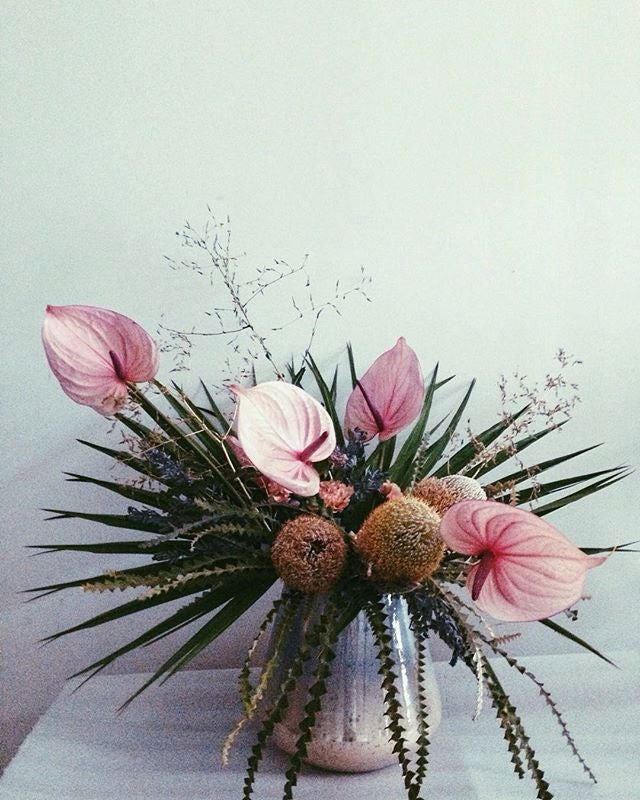The Freshest Flower Trends of 2018
Bring them home this spring.
Published May 2, 2019 6:02 PM
We may earn revenue from the products available on this page and participate in affiliate programs.
The floral industry is bursting with exciting contemporary designs that you can easily incorporate into your home. Our favorite floral designers reveal how you can incorporate the latest flower trends into your interior using existing decor, house plants, sophisticated color schemes, and good ol’ Mother Nature.
Tropical Tribute
Click through any design blog, and you’ll notice interiors spruced up with an array of house plants—from ficus trees to bromeliads. With their lush foliage and sculptural silhouette, tropical house plants are becoming fixtures in the home. Take this tropical movement a step further by incorporating exotic blooms into a tablescape, or displaying them simply in a vase.
“Tropical houseplants such as fig leaf, palm, and monstera are having a moment, and for good reason—they’re low maintenance and high impact,” says Mary Ellen LaFreniere of Baltimore, Maryland’s Steelcut Flower Co. “Tropical blooms are the same—protea, anthurium, and orchids provide opportunities for unexpected texture and color that require little upkeep, but will last much longer than traditional, garden-style arrangements.”
While blooms like protea don’t come cheap, they are well worth the money. They can last up to several weeks, depending on variety and freshness. These opulent flowers can also be mixed into existing houseplant foliage found around the house to create a bold arrangement.
Color of the Year
The interior design industry influences floral design in a variety of ways, from color to style. For instance, you can always count on Pantone’s Color of the Year making its way into floral arrangements. Pantone’s 2015 COTY Marsala is still in vogue three years later—you’ll find opulent arrangements filled with moody burgundy dahlias and peonies.
“We are veering away from the whites and blushes that have been so popular for the past year,” says LaFreniere. “We’ve been in this minimalist mindset, but now, people are ready to see color again.”
Pantone’s 2018 COTY Ultra Violet has already started to trickle down into the flower world. Flower farmer Mason Moomaw behind Richmond, Virginia’s Burst + Bloom is planning on doubling the amount of purple dahlias he is planting this year, as he knows shades of purple will be in high demand—specifically dahlia varietals like Thomas Edison (almost true Ultra Violet) and Ferncliff Illusion, a white dinner plate dahlia with purple edges.
While Ultra Violet is a bold color to find naturally in the wild, other softer and subtle purples are going to be popular too, like lavenders and lilacs.
Monochromatic
Interiors and outfits alike look sleek and sophisticated with a monochromatic color scheme. For a refined look, embrace the single color philosophy when creating an arrangement.
“I love working with monochromatic color palettes, as even an arrangement that is pink overall can have a wide variety of intricate color variation, texture, and floral variety,” says Kiana Underwood of San Francisco-based Tulipina.
Underwood’s new book Color Me Floral hits bookstores March 6, and walks readers through making arrangements for all sorts of gatherings throughout the year. Organized by season, Underwood provides 10 arrangements (one in each color) per season. Using bold colors, rich texture, and playful ingredients like edible berries, you can create a one-hued floral arrangement with plenty of personality.
The Great Outdoors
No matter the season, Mother Nature is always in vogue, and embellishing your home is as easy as walking out your front door and snipping some magnolia leaves or a blooming cherry blossom branch.
“While entertaining, I like to incorporate textural elements from outside, and tend to be drawn to a neutral color palette with hints of seasonal color,” says Brie Pflederer of Chicago-based Splendor of Eden. “I’m always inspired by nature, and love to bring the outside in for a tablescape.”
While foraging for plants in the great outdoors, look for more than foliage—think berries, branches, and seed pods that can add texture, shape, and dimension.
“While making your arrangement, get a few nice stems at your local florist. Then, mix in cut-offs from potted plants at home, or branches and greens if you have a garden,” says Ingrid Carozzi of Tin Can Studios in Brooklyn. “Don’t be afraid to mix in cut-offs from your potted plants; it will make your arrangement look more interesting.”
Use Existing Decor
For this arrangement seen above, Carozzi used a vase her mom brought her from Italy, and filled it with hellebore blooms and a quince branch that she gathered from outside.
Open your china cabinet and unearth the Waterford crystal and silver that you were gifted for your wedding. In lieu of the complimentary glass vase that came with your last Valentine’s Day arrangement, use a unique vessel like a brass bowl, vintage ginger jar, or antique garden planter.
“Don’t let your decor become dust collectors. Use that vase you inherited or bought on your honeymoon to put a flower arrangement in,” says Tin Can Studios’ Carozzi. “Wild looking, mixed arrangements with bright colors in a vase with some patina look beautiful in a more minimal room.”
See more fresh floral ideas:
How to Turn Supermarket Flowers into Cool Bouquets Brilliant DIY Projects That Turn Blooms Into Decor The Easiest Way to Make Any Flowers Look Expensive
